Kristine Hughes's Blog, page 124
June 24, 2012
Napoleon Invades Russia, June 24, 1812
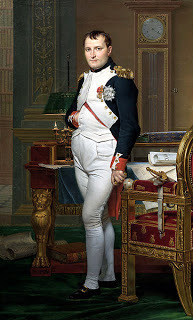 Napoleon in His Study, 1812Jacques-Louis David (1748-1825)National Gallery of Art, Washington D.C.
Napoleon in His Study, 1812Jacques-Louis David (1748-1825)National Gallery of Art, Washington D.C.Another bicentenary is here, though its connection to Britain is not quite direct. However, the failure of Napoleon's Russian invasion and the destruction of a large part of his army contributed to his ultimate defeat(s) by the allied nations led by Great Britain.
With the benefit of hindsight, historians have spent two hundred years pointing out the deficiencies in Napoleon's goals, strategies and execution. I have to admit most of my knowledge about Napoleon's Russian campaign was learned in Tolstoy's War and Peace, published in 1869.
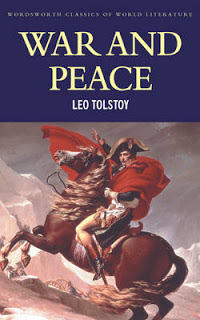
And since it is incredibly long (though also brilliant), I skimmed (or skipped) large sections. So my limited knowledge is, perhaps, more attributible to the 1956 film of War and Peace. I love that movie, starring Audrey Hepburn as Natasha, Mel Ferrar as Prince Andrei, and Henry Fonda as Count Pierre Bezukhov.
 War and Peace, directed by King Vidor
War and Peace, directed by King VidorThere have been other non-novel versions of Tolstoy's sprawling masterpiece, including an opera by Sergei Prokofiev, composed during World War II. I remember the 1956 film with great affection. In order to cover most of the story, however, it lasts about three and a half hours.
 War and Peace, Metropolitan Opera production 2002
War and Peace, Metropolitan Opera production 2002As everyone knows, Napoleon's campaign in Russia was a total disaster. Numbers vary but about half a million soldiers of the Grand Armee marched into Russia and only a fraction returned by the end of 1812. Well before the Russian campaign, Arthur Wellesley, later named first Duke of Wellington, began to turn the tide in the Peninsular War, invading Spain from Portugal in January, 1812. Wellington and the allies won the Battle of Salamanca, June 17-22, 1812. French Marshall Soult and his defeated troops fought on but slowly withdrew into France.
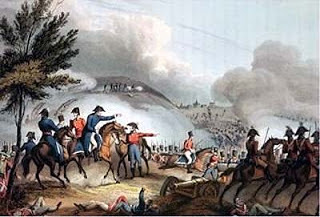 Battle of Salamanca, June 17-22, 1812
Battle of Salamanca, June 17-22, 1812On June 24th, having heard nothing about the British and Allied victory in Spain, Napoleon's troops crossed the river Niemen into what is now Lithuania, then Russian Poland. The Russians, greatly outnumbered, usually retreated or conducted brief skirmishes instead of standing and fighting as Napoleon's enemies usually did. In doing so, the Russians drew the French deeper and deeper into their sparsely populated regions, completely fouling up supply lines for the rapidly moving French. By mid-October, the French encircled Moscow, the capital. The Russians evacuated the city -- and it burned, whether set afire by the fleeing citizens or by the invading troops no one can know. Probably both.
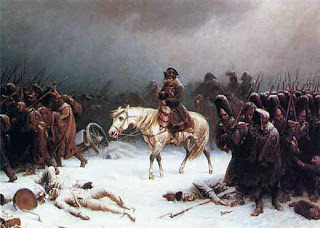 Napoleon's Retreat from Russiaby Alfred Northen (1828-1876)
Napoleon's Retreat from Russiaby Alfred Northen (1828-1876)On the long retreat in the frigid weather through land already stripped of all provisions, constantly harrassed by Russian troops and Cossack raiders, the French troops simply starved or froze. Supplies and artillery were abandoned. The horses also died or were consumed. By mid-December, when the last of the French left Russia, up to 380,000 men had been lost with almost 100,000 captured. It had been a national disaster for France and a personal catastrophe for Napoleon.
Published on June 24, 2012 01:00
June 22, 2012
London Walks
If you are lucky enought to be in London this season, be sure to take advantage of one of the city's best bargains: London Walks. Here is their website with their daily schedules.

Though I am missing out on London this year, I've visited at least once almost every year for the last 25 or so, and I never tire of tagging along with the London Walks guides. Not a single disappointment -- and I've been on quite a few of them at least twice.
There are many operators of walking tours and many may be excellent, but with London Walk, you can be confident you have an experienced and entertaining guide. Among the most popular walks (and operated by many it seems) is a night-time venture through the alleys of the East End in the footseps of Jack the Ripper. Note: you won't find him! I found the LW guide a fount of knowledge about the criminal, the victims, the crimes and the locale, with all sorts of facts included about the residents and architecture of the area, now largely gentrified. I didn't want a sideshow kind of tour -- and it wasn't. But be careful of copycat tour operators.
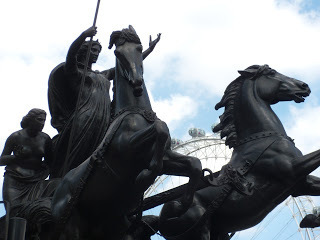 Bodecia on Westminster Bridge
Bodecia on Westminster Bridge
One of my favorites (well, they all are!) was a recent one: Old Westminster. I had told myself that since I'd visited Westminster Abbey, watched a debate in the House of Commons and walked across Westminister Bridge in the past, I really didn't need this tour. Was I wrong or WHAT? I learned so much! And that is exactly what happens on all the tours.
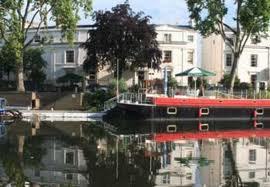 Little Venice
Little Venice
Also highly recommended: the Little Venice walk through a neighborhood not far from Paddington Station. You'll see lovely homes and a fascinating church with a monument to actress Sarah Siddons. St. Mary on Paddington Green is, for Regency lovers, more like churches looked in those days, before the Victorians tarted them up with fancy new stained glass and other gee-gaws.
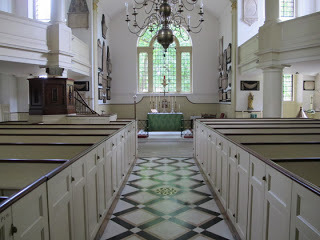 St. Mary Paddington Green, completed 1791
St. Mary Paddington Green, completed 1791
One of the Walks I have taken at least three times is Legal and Illegal London or the Inns of Court. You will learn all about the British legal system, the difference between solicitors and barristers, and how the law is taught and practiced while walking around the delightful buildings and gardens of the City.
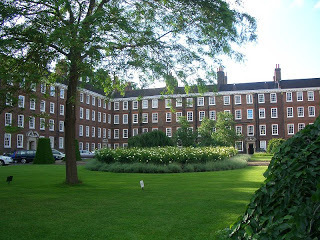 Gray's Inn
Gray's Inn
And you will visit the Temple Church, full of fascinating lore, dating from the 12th century, but with many renovations, including repairs after the Blitz.
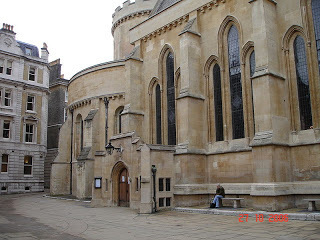 Temple Church
Temple Church
On the walk Secret London, you find out why there is a camel on the banks of the Thames and secrets of sculptor Sir Edwin Landseer's lion paws in Trafalgar Square.
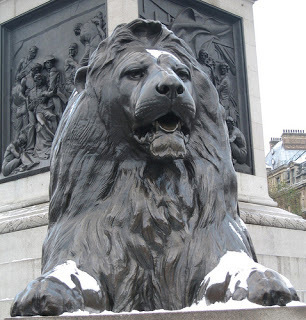
You'll find walks geared to fans of Harry Potter, the Beatles, Charles Dickens, Shakespeare and many more clever approaches to seeing the great city. There are some special opportunities to visit Olympic sites too. Each Walk takes about two hours (don't forget to visit the loo before starting out).
Most days of the week London Walks runs Explorer Days, to such not-to-be-missed- sights such as Stonehenge and Salisbury Cathedral, Canterbury, Bath, Oxford and many many more, all accessible by train. These cost a little more, but if you don't drive in England, it is a convenient way to see a bit of the countryside as well major cities.
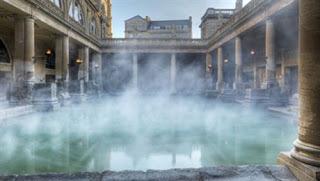 The Roman Baths, Bath
The Roman Baths, Bath
Another special set of walks visit pubs in the evening, a boon to those of us who sometimes visit solo and enjoy a bit of company with our pints (or I suggest half paints as you will visit several pubs and time is short at each one). Here is one of my favorite London pubs, though I can't remember which walk features it.
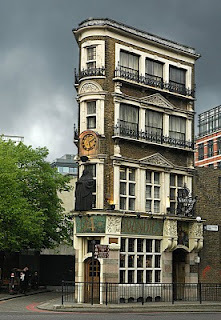 Blackfriars Pub
Blackfriars Pub
I hope this has convinced you to try out some of the London Walks on your next visit. You won't be sorry.
If you, like me, have to stay home this year, you might send for London Stories, published by London Walks, and written by David Tucker and the Guides. It's a good armchair companion. It's available on their website and elsewhere.
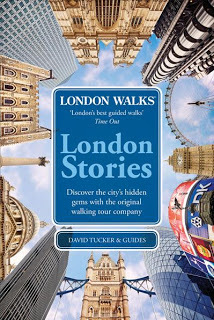


Though I am missing out on London this year, I've visited at least once almost every year for the last 25 or so, and I never tire of tagging along with the London Walks guides. Not a single disappointment -- and I've been on quite a few of them at least twice.
There are many operators of walking tours and many may be excellent, but with London Walk, you can be confident you have an experienced and entertaining guide. Among the most popular walks (and operated by many it seems) is a night-time venture through the alleys of the East End in the footseps of Jack the Ripper. Note: you won't find him! I found the LW guide a fount of knowledge about the criminal, the victims, the crimes and the locale, with all sorts of facts included about the residents and architecture of the area, now largely gentrified. I didn't want a sideshow kind of tour -- and it wasn't. But be careful of copycat tour operators.
 Bodecia on Westminster Bridge
Bodecia on Westminster BridgeOne of my favorites (well, they all are!) was a recent one: Old Westminster. I had told myself that since I'd visited Westminster Abbey, watched a debate in the House of Commons and walked across Westminister Bridge in the past, I really didn't need this tour. Was I wrong or WHAT? I learned so much! And that is exactly what happens on all the tours.
 Little Venice
Little VeniceAlso highly recommended: the Little Venice walk through a neighborhood not far from Paddington Station. You'll see lovely homes and a fascinating church with a monument to actress Sarah Siddons. St. Mary on Paddington Green is, for Regency lovers, more like churches looked in those days, before the Victorians tarted them up with fancy new stained glass and other gee-gaws.
 St. Mary Paddington Green, completed 1791
St. Mary Paddington Green, completed 1791One of the Walks I have taken at least three times is Legal and Illegal London or the Inns of Court. You will learn all about the British legal system, the difference between solicitors and barristers, and how the law is taught and practiced while walking around the delightful buildings and gardens of the City.
 Gray's Inn
Gray's InnAnd you will visit the Temple Church, full of fascinating lore, dating from the 12th century, but with many renovations, including repairs after the Blitz.
 Temple Church
Temple ChurchOn the walk Secret London, you find out why there is a camel on the banks of the Thames and secrets of sculptor Sir Edwin Landseer's lion paws in Trafalgar Square.

You'll find walks geared to fans of Harry Potter, the Beatles, Charles Dickens, Shakespeare and many more clever approaches to seeing the great city. There are some special opportunities to visit Olympic sites too. Each Walk takes about two hours (don't forget to visit the loo before starting out).
Most days of the week London Walks runs Explorer Days, to such not-to-be-missed- sights such as Stonehenge and Salisbury Cathedral, Canterbury, Bath, Oxford and many many more, all accessible by train. These cost a little more, but if you don't drive in England, it is a convenient way to see a bit of the countryside as well major cities.
 The Roman Baths, Bath
The Roman Baths, BathAnother special set of walks visit pubs in the evening, a boon to those of us who sometimes visit solo and enjoy a bit of company with our pints (or I suggest half paints as you will visit several pubs and time is short at each one). Here is one of my favorite London pubs, though I can't remember which walk features it.
 Blackfriars Pub
Blackfriars PubI hope this has convinced you to try out some of the London Walks on your next visit. You won't be sorry.
If you, like me, have to stay home this year, you might send for London Stories, published by London Walks, and written by David Tucker and the Guides. It's a good armchair companion. It's available on their website and elsewhere.

Published on June 22, 2012 01:00
June 20, 2012
Visiting the Birmingham Museum of Art
Now that the fabulous exhibition The Look of Love has closed in at the Birmingham Museum of Art in the largest city in Alabama, I want to encourage a visit to see the permanent collections. You will find many fascinating objects and stories. The website is here.
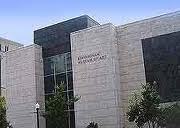
Because I found the exhibition of Lover's Eyes so exciting, I admit I skipped some of the Museum's excellent collections of Asisan, African, Native American, and pre-Colombian art -- which is really a shame. However, I lingered in the American and British galleries as long as I could.
In the American galleries, you will find outstanding works from many familiar artists and movements. One of my favorite groups is the Hudson River School, usually sweeping and dramatic views of the American landscape.
 Looking Down the Yosemite Valley, California, 1865 Alfred Bierstadt, German-American, 1830-1902
Looking Down the Yosemite Valley, California, 1865 Alfred Bierstadt, German-American, 1830-1902
Portraits are always popular, especially those of heroes -- and beautiful women.
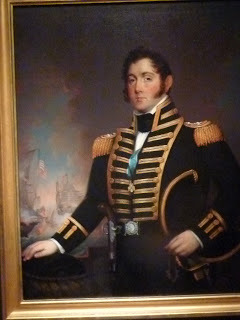 Portrait of Oliver Hazard Perry, Hero of Lake Erieby Jane Stuart (1812-1888)
Portrait of Oliver Hazard Perry, Hero of Lake Erieby Jane Stuart (1812-1888)
Jane Stuart was the daughter of that renowned painter of early Americans such as George Washington, Gilbert Stuart (1755-1828). Jane assisted her father in his work and after his death carried on his portraiture and promoted his legacy.
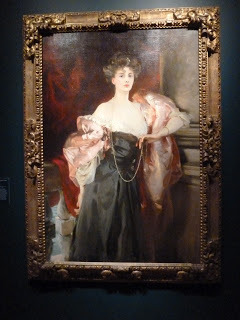 In the Galleries
In the Galleries
John Singer Sargent was well known in Europe and the U.S. for his outstanding portraiture, continuing the magnificent tradition of Lawrence, Gainsborough and Van Dyke. Lush colors, rich fabrics, flattering facial and body characteristics, and an overall impression of aristocracy were a few of the characteristics these artists shared.
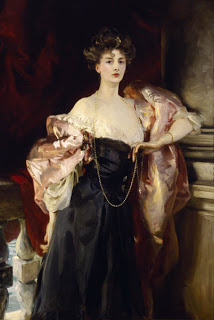 Lady Helen Vincent, Viscountess d'AbernonJohn Singer Sargent, American, 1856-1925
Lady Helen Vincent, Viscountess d'AbernonJohn Singer Sargent, American, 1856-1925
I notice that many museums have trouble deciding whether to put the work of Thomas Sully and Benjamin West in the British or American galleries. It seems to depend upon which side of the Atlantic the institution rests.
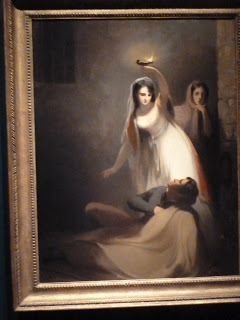 Thomas Sully, American, born England (1783-1872)Prison Scene from James Fenimore Cooper's The Pilot 1841"Cecilia Howard and Katherine Plowden arousing the prisoner Edward Griffiths from his slumber."
Thomas Sully, American, born England (1783-1872)Prison Scene from James Fenimore Cooper's The Pilot 1841"Cecilia Howard and Katherine Plowden arousing the prisoner Edward Griffiths from his slumber."
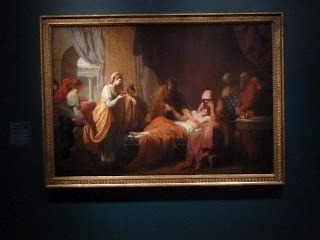 Erasistratus the Physician Discovers the Love of Antiochus for Stratonica, 1772
Erasistratus the Physician Discovers the Love of Antiochus for Stratonica, 1772
Benjamin West, b. U.S., d. Great Britain 1738-1820
Benjamin West was born in Pennsylvania and early in life showed artistic promise. He moved to London in 1863 and within a few years was named historical painter to George III. West served as second president of the Royal Academy of Art. The painting above is typical of the very popular style of large historical paintings in the third quarter of the 18th century. There are many fine portraits it he British Gallery by an array of excellent 18th and early 19th century artists.
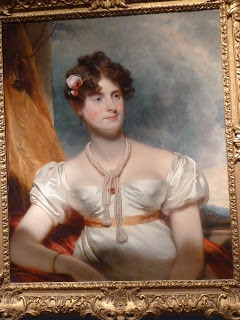 Unknown Sitter, by Sir Thomas Lawrence, British (1769-1830)ca. 1800
Unknown Sitter, by Sir Thomas Lawrence, British (1769-1830)ca. 1800
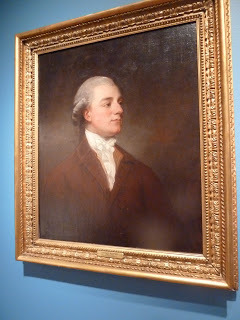 Wilson Gale-Braddyll (1756-1818) 1776by George Romney, English 1734-1802
Wilson Gale-Braddyll (1756-1818) 1776by George Romney, English 1734-1802
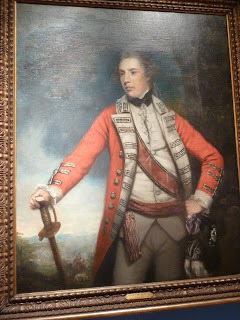 Captain Arthur Blake 1769Sir Joshua Reynolds, English (1723-1792)1st President of the Royal Academy of Art
Captain Arthur Blake 1769Sir Joshua Reynolds, English (1723-1792)1st President of the Royal Academy of Art
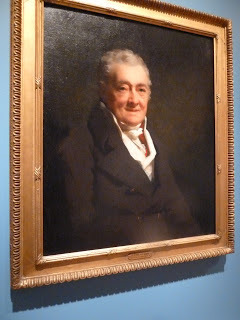 E. Finley, Esq.Sir Henry Raeburn, Scottish 1756-1823
E. Finley, Esq.Sir Henry Raeburn, Scottish 1756-1823
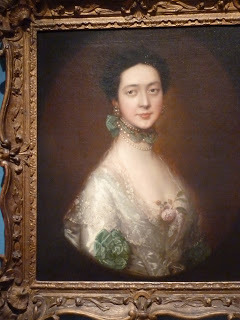 Mrs. William Monck 1760-65Thomas Gainsborough, English 1727-1788
Mrs. William Monck 1760-65Thomas Gainsborough, English 1727-1788
The Birmingham Museum of Art has wonderful collections of Decorative Arts, below a scene in the British Gallery.
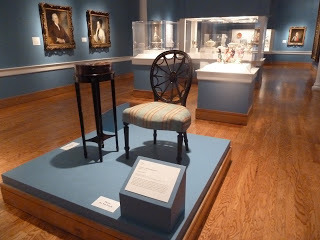
The chair, ca. 1775, originated in the workshop of Thomas Chippendale (1718-1779), mahogany, with modern upholstery.
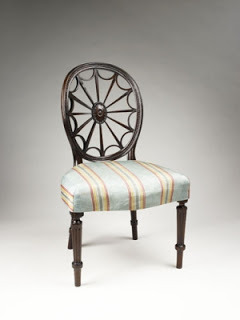
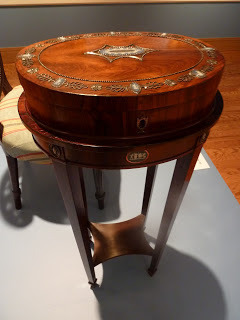 Sewing Box on Stand, 1790, attributed to Matthew Boulton, English (1728-1809)Rosewood with stoneware (jasperware), silver and cut steel
Sewing Box on Stand, 1790, attributed to Matthew Boulton, English (1728-1809)Rosewood with stoneware (jasperware), silver and cut steel
Below: Wedgwood, Britannia Triumphant, jasper; holding a portrait medallion of George III. Thought to have been made to commemorate the victory of British Naval forces over the French in 1798.
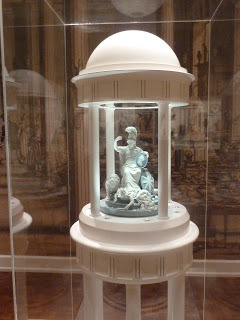
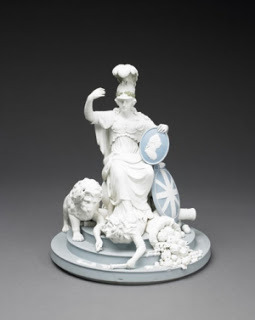 The figure itself, attributed to John Flaxman Jr., English, 175501826
The figure itself, attributed to John Flaxman Jr., English, 175501826
The collection of Wedgwood is stupendous, totalling almost 10,000 pieces from 1759 to the mid-20th century. Below of wall of medallions, mostly Jasper.
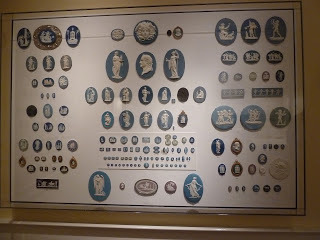
Below, a selection of vases from various Wedgwood periods.
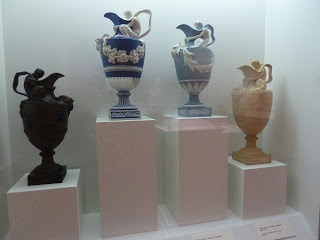
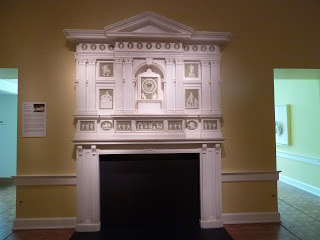 MantelpieceWedgwood, designed by Halsey Ricardo, England 1854-1928Originally made for Buckminster Park, Leicestershirehouse demolished 1952
MantelpieceWedgwood, designed by Halsey Ricardo, England 1854-1928Originally made for Buckminster Park, Leicestershirehouse demolished 1952
Obviously, I could go on for ages telling you about the glories of the museum. But I will leave that to you, as you investigate their very fine website. I close with a final piece, a charming cherub head that caught my eye.
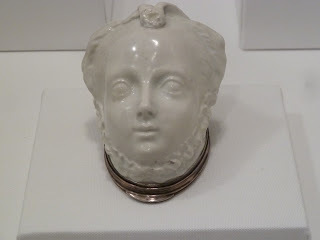 Scent Bottle, ca. 1750soft paste porcelain with gold mountfrom the Chelsea Porcelain ManufactoryChelsea, England
Scent Bottle, ca. 1750soft paste porcelain with gold mountfrom the Chelsea Porcelain ManufactoryChelsea, England

Because I found the exhibition of Lover's Eyes so exciting, I admit I skipped some of the Museum's excellent collections of Asisan, African, Native American, and pre-Colombian art -- which is really a shame. However, I lingered in the American and British galleries as long as I could.
In the American galleries, you will find outstanding works from many familiar artists and movements. One of my favorite groups is the Hudson River School, usually sweeping and dramatic views of the American landscape.
 Looking Down the Yosemite Valley, California, 1865 Alfred Bierstadt, German-American, 1830-1902
Looking Down the Yosemite Valley, California, 1865 Alfred Bierstadt, German-American, 1830-1902Portraits are always popular, especially those of heroes -- and beautiful women.
 Portrait of Oliver Hazard Perry, Hero of Lake Erieby Jane Stuart (1812-1888)
Portrait of Oliver Hazard Perry, Hero of Lake Erieby Jane Stuart (1812-1888)Jane Stuart was the daughter of that renowned painter of early Americans such as George Washington, Gilbert Stuart (1755-1828). Jane assisted her father in his work and after his death carried on his portraiture and promoted his legacy.
 In the Galleries
In the GalleriesJohn Singer Sargent was well known in Europe and the U.S. for his outstanding portraiture, continuing the magnificent tradition of Lawrence, Gainsborough and Van Dyke. Lush colors, rich fabrics, flattering facial and body characteristics, and an overall impression of aristocracy were a few of the characteristics these artists shared.
 Lady Helen Vincent, Viscountess d'AbernonJohn Singer Sargent, American, 1856-1925
Lady Helen Vincent, Viscountess d'AbernonJohn Singer Sargent, American, 1856-1925I notice that many museums have trouble deciding whether to put the work of Thomas Sully and Benjamin West in the British or American galleries. It seems to depend upon which side of the Atlantic the institution rests.
 Thomas Sully, American, born England (1783-1872)Prison Scene from James Fenimore Cooper's The Pilot 1841"Cecilia Howard and Katherine Plowden arousing the prisoner Edward Griffiths from his slumber."
Thomas Sully, American, born England (1783-1872)Prison Scene from James Fenimore Cooper's The Pilot 1841"Cecilia Howard and Katherine Plowden arousing the prisoner Edward Griffiths from his slumber."  Erasistratus the Physician Discovers the Love of Antiochus for Stratonica, 1772
Erasistratus the Physician Discovers the Love of Antiochus for Stratonica, 1772Benjamin West, b. U.S., d. Great Britain 1738-1820
Benjamin West was born in Pennsylvania and early in life showed artistic promise. He moved to London in 1863 and within a few years was named historical painter to George III. West served as second president of the Royal Academy of Art. The painting above is typical of the very popular style of large historical paintings in the third quarter of the 18th century. There are many fine portraits it he British Gallery by an array of excellent 18th and early 19th century artists.
 Unknown Sitter, by Sir Thomas Lawrence, British (1769-1830)ca. 1800
Unknown Sitter, by Sir Thomas Lawrence, British (1769-1830)ca. 1800 Wilson Gale-Braddyll (1756-1818) 1776by George Romney, English 1734-1802
Wilson Gale-Braddyll (1756-1818) 1776by George Romney, English 1734-1802 Captain Arthur Blake 1769Sir Joshua Reynolds, English (1723-1792)1st President of the Royal Academy of Art
Captain Arthur Blake 1769Sir Joshua Reynolds, English (1723-1792)1st President of the Royal Academy of Art E. Finley, Esq.Sir Henry Raeburn, Scottish 1756-1823
E. Finley, Esq.Sir Henry Raeburn, Scottish 1756-1823 Mrs. William Monck 1760-65Thomas Gainsborough, English 1727-1788
Mrs. William Monck 1760-65Thomas Gainsborough, English 1727-1788The Birmingham Museum of Art has wonderful collections of Decorative Arts, below a scene in the British Gallery.

The chair, ca. 1775, originated in the workshop of Thomas Chippendale (1718-1779), mahogany, with modern upholstery.

 Sewing Box on Stand, 1790, attributed to Matthew Boulton, English (1728-1809)Rosewood with stoneware (jasperware), silver and cut steel
Sewing Box on Stand, 1790, attributed to Matthew Boulton, English (1728-1809)Rosewood with stoneware (jasperware), silver and cut steelBelow: Wedgwood, Britannia Triumphant, jasper; holding a portrait medallion of George III. Thought to have been made to commemorate the victory of British Naval forces over the French in 1798.

 The figure itself, attributed to John Flaxman Jr., English, 175501826
The figure itself, attributed to John Flaxman Jr., English, 175501826The collection of Wedgwood is stupendous, totalling almost 10,000 pieces from 1759 to the mid-20th century. Below of wall of medallions, mostly Jasper.

Below, a selection of vases from various Wedgwood periods.

 MantelpieceWedgwood, designed by Halsey Ricardo, England 1854-1928Originally made for Buckminster Park, Leicestershirehouse demolished 1952
MantelpieceWedgwood, designed by Halsey Ricardo, England 1854-1928Originally made for Buckminster Park, Leicestershirehouse demolished 1952Obviously, I could go on for ages telling you about the glories of the museum. But I will leave that to you, as you investigate their very fine website. I close with a final piece, a charming cherub head that caught my eye.
 Scent Bottle, ca. 1750soft paste porcelain with gold mountfrom the Chelsea Porcelain ManufactoryChelsea, England
Scent Bottle, ca. 1750soft paste porcelain with gold mountfrom the Chelsea Porcelain ManufactoryChelsea, England
Published on June 20, 2012 01:00
June 18, 2012
The War of 1812 Begins: The U.S. Declares War on Great Britain
On June 18, 1812, President James Madison signed an Act of Congress declaring war on the United Kingdom of Great Britain and Ireland. The next day he issued a proclamation of war, here.
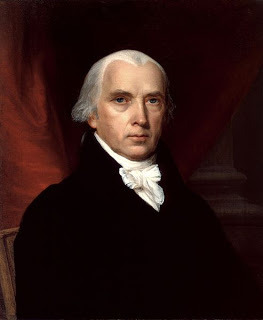 James Madison, 4th President of the United States of America
James Madison, 4th President of the United States of America
The War of 1812 is almost forgotten in both the U.S. and U.K., but to many Canadians, it is an important aspect of their history, ending for the most part, U.S. attempts to control and annex parts of Canada.
Historian Alan Taylor of the University of California-Davis has written a book advancing the theory that the war was "in effect a civil war between related members of a founding nation." In The Civil War of 1812: American Citizens, British Subjects, Irish Rebels, and Indian Allies, Taylor looks at the conflict from multiple points of view.
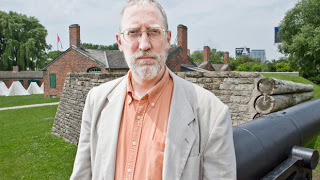 U.S. Historian Alan Taylor in Toronto
U.S. Historian Alan Taylor in Toronto
An interesting article from the Canadian Broadcasting Company on Alan Taylor's book is here. This site will also connect you to various Canadian commemorations of the War of 1812.
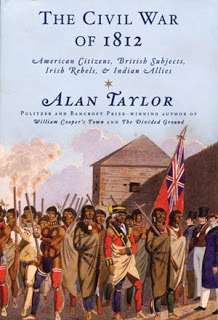
As I remember from my high school American History course, the impressment of American seamen by British ships on the high seas was a basic cause of U.S. complaints. The British, embroiled in the Napoleonic Wars on the Peninsula and the Continent, claimed the right to stop and board ships to find deserters; sometimes they were also said to have taken naturalized or other Americans to force them to serve the British Navy. A further aggravation to the growing American merchant fleet were the Orders in Council, His Majesty's naval blockade of continental ports, as part of the war with France.
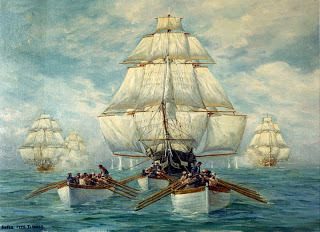 USS Constitution, in action 1812, painted byAnton Otto Fischer, U.S. Naval Historical Center
USS Constitution, in action 1812, painted byAnton Otto Fischer, U.S. Naval Historical Center
Historians have added additional motivations for declaring war. The U.S. definitely wanted to control more of Canada. Growing controversy among the War Hawks and the fledgling political parties put President Madison in a bind. The war debate in Congress was heated and extremely partisan, only barely passed by Madison's political allies. Further, U.S. expansion caused continual controversy with Native Americans, who often turned to the British Army for assistance. We all know the sad story of the fate of the Native Americans, moved farther and farther west away from their ancestral homes.
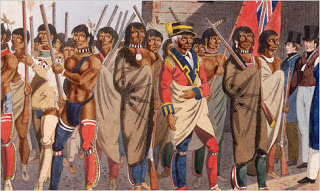
One wonders why the young, weak, and struggling United States of America would attempt to defeat the strongest maritime nation in the world. The U.S. Constitution had been in effect for less than a quarter of a century; there was no professional army; instead the government had to rely on little-trained state militias. One can hardly avoid the suspicion many leaders in the U.S. relied upon the British being quite thoroughly preoccupied with war against Napoleon.
Another factor was the very slow process of communication in those days. Upon the declaration of war, the U.S. had not heard that British Prime Minister Perceval had been assassinated on May 11, 1812, and replaced by a government headed by Lord Liverpool (1770-1828, Prime Minister 1812-1827). He had already rescinded the Orders in Council before the formal declaration, but who knew in Washington?
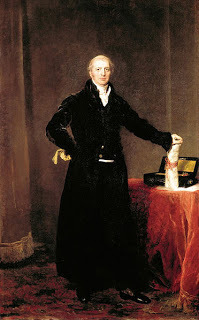 Robert Jenkinson, 2rd Earl of Liverpoolby Sir Thomas Lawrence
Robert Jenkinson, 2rd Earl of Liverpoolby Sir Thomas Lawrence
We don't have to provide a spoiler alert to reveal that the war led to nothing, for all practical purposes, on the part of the U.S. and U.K. In Canada, it was seen as confirming their unique relationship with both their neighbor to the south and the British. The Treaty of Ghent confirmed the status quo ante bellum, that is, a return to the situation before the war was declared. The hostilities had been in vain.
Among the commemorations in the U.S., the estate of James Madison (1751-1836), near Jefferson's Monticello, will host a number of events. Their website is here.
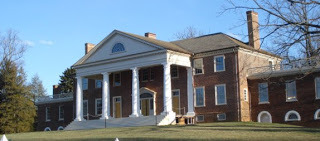 Montpelier, near Charlottesville, Virginia
Montpelier, near Charlottesville, Virginia
The U.S. did have a few contributions to its popular history from the War of 1812, such as the composition of the Star Spangled Banner in 1814 by Francis Scott Key as he watched the bombardment of Fort McHenry in Baltimore Harbor. For more on the flag at the Smithsonian, click here.
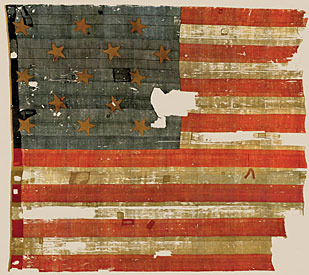
During naval battles on Lake Erie, one of the more memorable of American legends took place when Oliver Hazard Perry (1785-1819), commanding the U.S. ships, won and reported to General William Henry Harrison, "We have met the enemy and they are ours: two ships, two brigs, one schooner and one sloop."
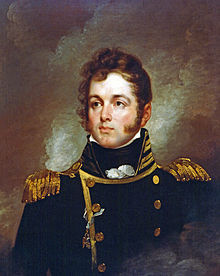 Captain Oliver H. Perry U.S. Naval Academy Museum Collection
Captain Oliver H. Perry U.S. Naval Academy Museum Collection
Andrew Jackson (1767-1845) came into national prominence after his victory in the Battle of New Orleans, a totally unnecessary event that took place after the peace treaty had been signed ending the war. That battle cost the life of General Edward Pakenham, brother-in-law of the first Duke of Wellington and the deaths of hundreds of British and less than a dozen American soldiers. Jackson later became the 7th president of the U.S, serving from 1829-1837.
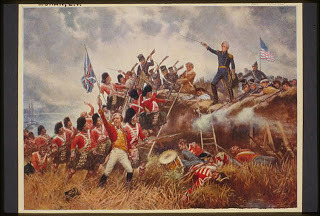 Battle of New Orleans, as painted by Edward Percy Moran in 1910Library of Congress
Battle of New Orleans, as painted by Edward Percy Moran in 1910Library of Congress
From time to time, we hope to return to the battles, mishaps, and personalities of the War of 1812 . Stay tuned.
 James Madison, 4th President of the United States of America
James Madison, 4th President of the United States of AmericaThe War of 1812 is almost forgotten in both the U.S. and U.K., but to many Canadians, it is an important aspect of their history, ending for the most part, U.S. attempts to control and annex parts of Canada.
Historian Alan Taylor of the University of California-Davis has written a book advancing the theory that the war was "in effect a civil war between related members of a founding nation." In The Civil War of 1812: American Citizens, British Subjects, Irish Rebels, and Indian Allies, Taylor looks at the conflict from multiple points of view.
 U.S. Historian Alan Taylor in Toronto
U.S. Historian Alan Taylor in TorontoAn interesting article from the Canadian Broadcasting Company on Alan Taylor's book is here. This site will also connect you to various Canadian commemorations of the War of 1812.

As I remember from my high school American History course, the impressment of American seamen by British ships on the high seas was a basic cause of U.S. complaints. The British, embroiled in the Napoleonic Wars on the Peninsula and the Continent, claimed the right to stop and board ships to find deserters; sometimes they were also said to have taken naturalized or other Americans to force them to serve the British Navy. A further aggravation to the growing American merchant fleet were the Orders in Council, His Majesty's naval blockade of continental ports, as part of the war with France.
 USS Constitution, in action 1812, painted byAnton Otto Fischer, U.S. Naval Historical Center
USS Constitution, in action 1812, painted byAnton Otto Fischer, U.S. Naval Historical Center Historians have added additional motivations for declaring war. The U.S. definitely wanted to control more of Canada. Growing controversy among the War Hawks and the fledgling political parties put President Madison in a bind. The war debate in Congress was heated and extremely partisan, only barely passed by Madison's political allies. Further, U.S. expansion caused continual controversy with Native Americans, who often turned to the British Army for assistance. We all know the sad story of the fate of the Native Americans, moved farther and farther west away from their ancestral homes.

One wonders why the young, weak, and struggling United States of America would attempt to defeat the strongest maritime nation in the world. The U.S. Constitution had been in effect for less than a quarter of a century; there was no professional army; instead the government had to rely on little-trained state militias. One can hardly avoid the suspicion many leaders in the U.S. relied upon the British being quite thoroughly preoccupied with war against Napoleon.
Another factor was the very slow process of communication in those days. Upon the declaration of war, the U.S. had not heard that British Prime Minister Perceval had been assassinated on May 11, 1812, and replaced by a government headed by Lord Liverpool (1770-1828, Prime Minister 1812-1827). He had already rescinded the Orders in Council before the formal declaration, but who knew in Washington?
 Robert Jenkinson, 2rd Earl of Liverpoolby Sir Thomas Lawrence
Robert Jenkinson, 2rd Earl of Liverpoolby Sir Thomas LawrenceWe don't have to provide a spoiler alert to reveal that the war led to nothing, for all practical purposes, on the part of the U.S. and U.K. In Canada, it was seen as confirming their unique relationship with both their neighbor to the south and the British. The Treaty of Ghent confirmed the status quo ante bellum, that is, a return to the situation before the war was declared. The hostilities had been in vain.
Among the commemorations in the U.S., the estate of James Madison (1751-1836), near Jefferson's Monticello, will host a number of events. Their website is here.
 Montpelier, near Charlottesville, Virginia
Montpelier, near Charlottesville, VirginiaThe U.S. did have a few contributions to its popular history from the War of 1812, such as the composition of the Star Spangled Banner in 1814 by Francis Scott Key as he watched the bombardment of Fort McHenry in Baltimore Harbor. For more on the flag at the Smithsonian, click here.

During naval battles on Lake Erie, one of the more memorable of American legends took place when Oliver Hazard Perry (1785-1819), commanding the U.S. ships, won and reported to General William Henry Harrison, "We have met the enemy and they are ours: two ships, two brigs, one schooner and one sloop."
 Captain Oliver H. Perry U.S. Naval Academy Museum Collection
Captain Oliver H. Perry U.S. Naval Academy Museum CollectionAndrew Jackson (1767-1845) came into national prominence after his victory in the Battle of New Orleans, a totally unnecessary event that took place after the peace treaty had been signed ending the war. That battle cost the life of General Edward Pakenham, brother-in-law of the first Duke of Wellington and the deaths of hundreds of British and less than a dozen American soldiers. Jackson later became the 7th president of the U.S, serving from 1829-1837.
 Battle of New Orleans, as painted by Edward Percy Moran in 1910Library of Congress
Battle of New Orleans, as painted by Edward Percy Moran in 1910Library of CongressFrom time to time, we hope to return to the battles, mishaps, and personalities of the War of 1812 . Stay tuned.
Published on June 18, 2012 01:00
June 15, 2012
The Story of Lily, Duchess of Marlborough
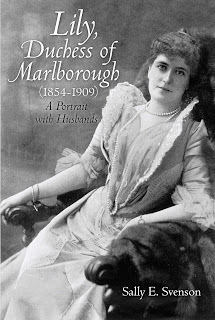
Author Sally Svenson has written a fascinating biography: Lily, Duchess of Marlborough (1854-1909) A Portrait with Husbands. Lily, born in Troy NY, had three husbands, none of whom lived for many years after the marriage, so most of her life was led as a widow, albeit alone with a considerable fortune at hand and personal acumen as a business woman. Lily is the least well-known of the three famous American heiresses who married into the Spencer-Churchill family of Blenheim Palace in the 19th century.
The first of the three, Jennie Jerome of New York (1854-1921), married Randolph Churchill in 1874, a second son of the 7th Duke of Marlborough. They had two sons, Jack (1880-1947) and Winston (1874-1965), the most famous statesman of the 20th century. After Lord Randolph's death, Jennie married George Cornwallis West in 1900; they were divorced in 1914.
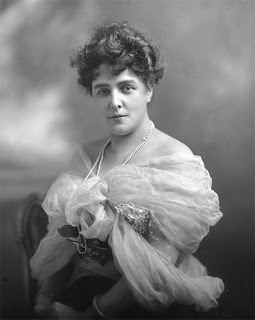 Jennie Jerome, Lady Randolph Churchill
Jennie Jerome, Lady Randolph ChurchillLily was the second American woman in the Churchill family (more about her later), and the third was Consuelo Vanderbilt (1877-1964) who married Lily's step son, known as Sunny, in 1895. A child of Lily's husband, 8th Duke of Marlborough, by his first marriage, Sunny (note: he wasn't really) had succeeded Lily's husband as the 9th Duke. Consuelo was forced into the marriage by her insistent mother Alva Vanderbilt; she produced an heir and a spare for the Duke before their separation and divorce. She later married Jacques Balsan, and was reputedly happy in the relationship.
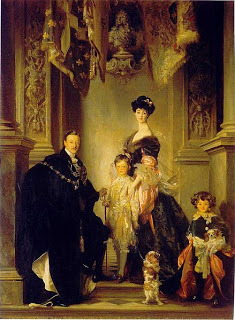 The Marlboroughts: Charles (9th duke), John (10th duke), Consuelo, and Lord Ivor Spencer-Churchillby John Singer Sargent, 1905, Blenheim Palace
The Marlboroughts: Charles (9th duke), John (10th duke), Consuelo, and Lord Ivor Spencer-Churchillby John Singer Sargent, 1905, Blenheim PalaceWhile the famous life and loves of Jennie have been extensively chronicled and the fate of Copnsuelo told in an autobiography as well as books about her and her mother, Lily Price Hamersly Spencer-Churchill Beresford has received much less attention.
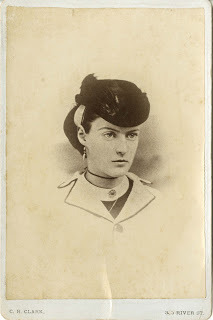 Lily, about age 16, ca.1870
Lily, about age 16, ca.1870Until now. Born Lilian Price, in Troy New York, Lily spent time with her aunts in high social circles in Washington, DC, in the years following the Civil War. Eventually she married Louis C. Hamersley in 1879. With his father, Louis had considerable real estate holdings in Manhattan. Lily, in residence at 257 Fifth Avenue, moved into the rarefied circle of New York socialites. She was a patron of the young Metropolitan Opera and other prominent organizations in New York. But Louis died in 1883, leaving her a widow at age 28.
Blessed with beauty and stature, Lily had to plan for the future. The wills of her father-in-law and husband were contested by members of the extended family for many years, though she was never completely without funds.
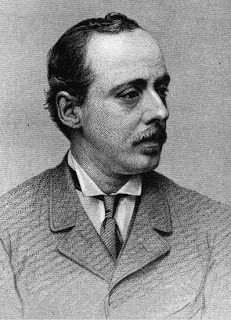 George Spencer-Churchill, 8th Duke of Marlborough, ca. 1876
George Spencer-Churchill, 8th Duke of Marlborough, ca. 1876Svenson's biography is at its best when relating the marital ins-and-outs of the high society and aristocratic circles of the late 19th century, particularly in England. For the blog account, let me say simply that the Duke had a scandalous reputation, sometimes called the Wicked Duke. Lily was discouraged by many of her New York friends from marrying him, but that is exactly what she did in 1888, thus becoming the first American-born British duchess in five decades.
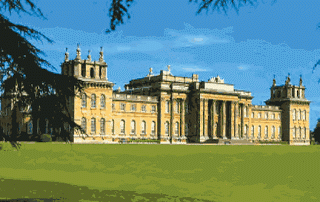 Blenheim Palace, Oxfordshire
Blenheim Palace, Oxfordshire</></>Though without full access to her eventual inheritance from her husband, Lily took a great interest in the repair and conservation of the Duke's magnificent home and its extensive grounds.
As an aside, I will report I have visited Blenheim and found it difficult to envision as a family home. While splendid in every way, I found it dark; many rooms, despite their gilded furniture, are rather dreary. No doubt an honest accounting of the continuing costs of its upkeep make it a millstone around the necks of the Spencer-Churchill family, as it has been since its beginning.
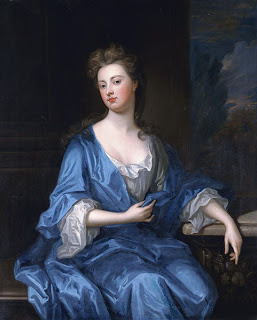 Sarah Jennings Churchill, first Duchess of Marlborough
Sarah Jennings Churchill, first Duchess of MarlboroughIntended as the gift of a grateful Queen Anne and her subjects to John Churchill (1650-1722), first Duke of Marlborough, after his victory in the Battle of Blenheim in 1704, the house built on the royal estate of Woodstock was the source of conflict. Various complications led to the Churchills having to finance a considerable amount of its costs themselves, greatly incensing the powerful first duchess. The burden of its upkeep continues to this day. Despite the infusion of money from Lily, Blenheim needed further cash, said to be the motivation for the marriage of the 9th Duke to Consuelo, whose father financed many more improvements.
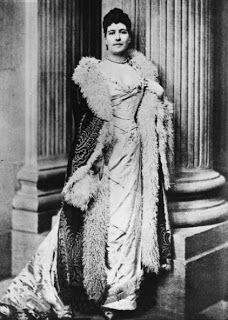 Lily Beresford, ca. 1890
Lily Beresford, ca. 1890 The 8th Duke of Marlborough lived only a few years after his marriage, dying in 1892 at the age of 48. According to Svenson, the marriage had been a compatible one, but Lily was again a widow at 38. She purchased an estate in Surrey, known as Deepdene where she set about entertaining and doing charitable work in the nearby village of Dorking.
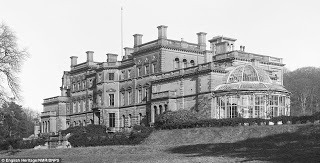
The story of her life at Deepdene interested me particularly. Later, she met and married Lord William de la Poer Beresford (1847-1900), war hero, popular sportsman and member of an aristocratic Anglo-Irish family. Under his guidance, Lily learned to love horse-racing and helped Lord William to develop a prominent racing stud.
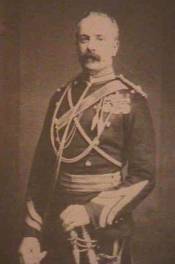 Lord William de la Poer Beresford
Lord William de la Poer BeresfordLily became a mother for the first time at the age of 42. Before her son was born, however, Lord William suffered a hunting accident (1896) from which he never fully recovered. Young William was born in February, 1897; his father died in late 1900 at age 53. Young William was always considered delicate; he died in 1919, perhaps in the influenza epidemic.
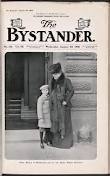 Lily and her son
Lily and her sonLily, alone again after the death of Lord William, did not marry again and devoted herself to her son, her gardens, farming interests at Deepdene, the opera in London, and local charities. She passed away in January, 1908.
Sadly, the great house at Deepdene became a hotel in 1920, later the wartime headquarters of a railroad, and was demolished in the mid-1960's.
This account of Lily's life only scratches the surface. I certainly could see many incidents and characters in Lily's life that must have influenced the story of Downton Abbey: an American heiress, protection of a great property, complicated entails and inheritance rules, and the exalted life of the rich on the eve of the Great War. I hope this account has stimulated your interest in this intriguing lady and her times. You will thoroughly enjoy the book. Author Sally Svenson's website is here.
Published on June 15, 2012 23:52
Waterloo Skeleton Found
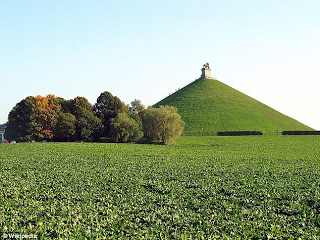
As the 200th Anniversary of the Battle of Waterloo approaches, a stunning discovery was made near the site of the Lion's Mound - the intact skeleton of a British soldier. Crews were working on constructing a parking lot when a piece of equipment uncovered the remains, unfortunately destroying the skull in the process. However, other artifacts were uncovered along with the: a spoon, coins and the musket ball believed to have caused his death still between his ribs. Historians believe he is from one of the Duke of Wellington’s British regiments, and described the discovery of the skeleton as one of the best ever war finds.
Yves Van Der Cruysen, director of the Battle of Waterloo Association, said: ‘This is a major discovery. "It is the first time for over a hundred years that a complete corpse of a combatant from the time has been discovered in such a good state."
"He could have been buried by a comrade or simply missed when the bodies were gathered up after the battle for burial. We hope to find evidence of his regiment from the spoon and the leather epaulets that were found with the corpse. And we know the names of the combatants thanks to military records of the time. When the soldier’s regiment can be determined we should be able to find his identity."
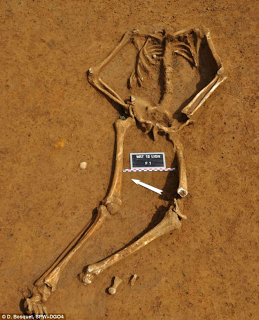
You can read the entire story here.
Thanks to our loyal reader June Sproat for the heads up on this story!
Published on June 15, 2012 01:01
June 14, 2012
What's a Manège?
If you know this blog, then you know that I spend an inordinate amount of time looking at UK property listings. From Grade I Listed historic estates to the smallest timbered cottage, I've taken virtual tours of just about every type house that can be found in Britain. Often, the property listings include a list of outbuildings and other features - paddocks, stabling, ornamental lakes, coach houses, conservatories, etc., etc., etc. Occasionally, I'll find mention of something called a "Manège." Time and again, I've asked myself, "Exactly what in the heck is a manège?" A manger? A manger in the French manner? Something one manages? A management office? A farm office? Hhhhmmmm . . . . .
According to Merriam-Webster.com, a manège is:
1: a school for teaching horsemanship and for training horses 2: the art of horsemanship or of training horses 3: the movements or paces of a trained horse Other than this, the availability of internet information concerning the manege is slim to none. Go on, Google the word, I'll wait . . . . . see? I did find a website called Equine World UK, where I found the following useful information:
A horse riding manege or dressage arena is usually marked around the edge with letters. In the riding lesson or during a dressage test this enables instructions to be given as to when to perform a particular action. Arena sizes may vary but most riding schools have an arena that is 20 metres by 40 metres, whilst others may have an arena that is 20 metres by 60 metres.
The images below shows the location of the letters that denote a particular point in the arena. Although there may be physical markers around the edge of the arena, there are no markers to identify the positions of the internal letters and so these must be memorised.
20m x 40m Arena
So, a manège is an indoor riding ring or school. And should never be confused with a ménage, which is the French word for "household," or with the French term "ménage à trois," which may be the topic of a future post, perhaps featuring the Hamiltons or the Duke of Devonshire.
Perhaps the most famous indoor riding school is the Spanish Riding School in Vienna, where the famous Lipizzaner stallions are trained and housed.
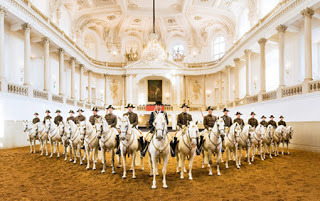
For more on the Stallions and their training, click here.
According to Merriam-Webster.com, a manège is:
1: a school for teaching horsemanship and for training horses 2: the art of horsemanship or of training horses 3: the movements or paces of a trained horse Other than this, the availability of internet information concerning the manege is slim to none. Go on, Google the word, I'll wait . . . . . see? I did find a website called Equine World UK, where I found the following useful information:
A horse riding manege or dressage arena is usually marked around the edge with letters. In the riding lesson or during a dressage test this enables instructions to be given as to when to perform a particular action. Arena sizes may vary but most riding schools have an arena that is 20 metres by 40 metres, whilst others may have an arena that is 20 metres by 60 metres.
The images below shows the location of the letters that denote a particular point in the arena. Although there may be physical markers around the edge of the arena, there are no markers to identify the positions of the internal letters and so these must be memorised.
20m x 40m Arena

So, a manège is an indoor riding ring or school. And should never be confused with a ménage, which is the French word for "household," or with the French term "ménage à trois," which may be the topic of a future post, perhaps featuring the Hamiltons or the Duke of Devonshire.
Perhaps the most famous indoor riding school is the Spanish Riding School in Vienna, where the famous Lipizzaner stallions are trained and housed.

For more on the Stallions and their training, click here.
Published on June 14, 2012 00:33
June 11, 2012
SAVE Britain's Heritage
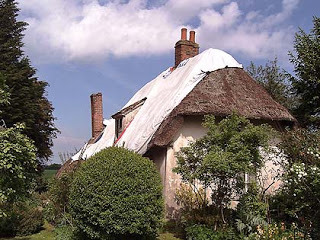
An organization called SAVE Britain's Heritage has been campaigning for historic buildings since its formation in 1975 by a group of architects, journalists and planners. Its Dare to Care: Buildings at Risk 2012-13 report, published June 1, contains almost one hundred homes in need of restoration, from castles to cottages.
Buildings featured in the 2012 report, Dare to Care, range from enchanting cottages, such as Shellards Cottage above, farmhouses and town houses to forlorn country piles, deserted chapels and crumbling mills - all crying out for restoration. These neglected treasures, ripe for sensitive repair, often lie in idyllic locations, surrounded by fields or in country villages or beside rivers and canals.
SAVE's latest report contains almost 100 new cases, resulting from a major consultation with local authorities in England. It also features up-to-date case histories of buildings rescued since appearing in earlier SAVE reports. Finally, the report highlights the scandalous waste of several historic buildings over the past twelve months. These include the demolition of a 19th-century brewer's villa in Hungerford, Berkshire, and the imminent destruction of Charles Barry's elegant Royal Sussex County Hospital in Brighton.
A must read for anyone interested in Britain's heritage and an essential tool for prospective restorers, SAVE's reports play a critical role in the conservation of Britain's historic buildings. Some two-thirds of the country houses included in SAVE's first report, published in 1977, had found new owners or uses within three or four years and good news has continued ever since. Marcus Binney, SAVE's President says, 'This is the 23rd of SAVE's annual reports on buildings at risk, each one illustrating a remarkable selection of endangered properties in varying states of repair, but all candidates for immediate action.'
Here are some highlights from the 2012 report:
Milton Damerell House, Devon: this treasure trove of architectural detail and history is currently on the market for £495,000. Dating back to 1500, this handsome Grade II listed house is an amalgamation of four centuries of architecture. Thought to have been a vicarage at one time, and located within beautiful countryside, this building boasts extraordinary surviving features and the promise of a mysterious hidden tunnel.
Shellards Cottage, (above) Essex: This historical gem, a charming thatched cottage built around 1500, is situated at the end of a country lane and would make a delightful home or rural bolt hole.
Ivy Cottage in County Durham: When this idyllic house - which dates back to the 17th century - was listed in 1987 the Inspector recorded that it was already empty and derelict. Two decades later, this picturesque sandstone building, in a small rural village, continues to cry out for a new owner and a new life.
The Georgian Toll Cottage at Marple, near Stockport: stands in a picturesque position next to a hump bridge at the junction of the Peak Forest and Macclesfield Canals. Pathetically boarded up, it cries out for some TLC.
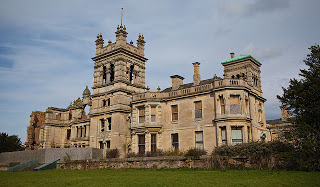
Overstone Hall, (above) on the outskirts of Northampton: is a majestic Italianate mansion in a 40 acre walled park but poses a considerable challenge. It was built in 1866 to the designs of W M Teulon, younger brother of the great Victorian 'rogue' architect S S Teulon. After suffering a fire it was put up for sale two years ago. It would make for a magnificent hotel, offices, or could be adapted sensitively for multiple residential use.
For further information, visit the Save Britain's Heritage website.
Published on June 11, 2012 23:31
June 9, 2012
Windsor Greys Jubilee Statue Appeal
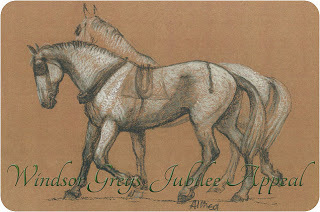
Private individuals in Windsor and Berkshire are seeking to raise funds for the Windsor Greys Jubilee project to raise a statue to a pair of Windsor Greys, the breed of horse that always draw the Queen's carriage, as well as all the Royal carriages - see photo below of the Greys pulling William and Kate's Wedding Carriage. Windsor Greys are not a specific breed of horse but are rather a name applied to a group of horses that are specially bred and selected according to appearance and temperament for the ceremonial duties of the British Monarchy. At present, about thirty Greys are in Royal service and are housed at the Royal Mews.
The statue project suffered a setback when the chosen artist, sculptor Althea Wynne, was killed in a car crash. Robert Rattray, a sculptor specializing in wildlife, will now carry the project forward. It is hoped that the bronze statue will be placed on the A308/A322 roundabout adjoining the Long Walk in Windsor and will commemorate Queen Elizabeth's Diamond Jubilee in the town of Windsor, as Queen Victoria's Diamond Jubilee is commemorated there by the statue of that monarch at the entrance of Windsor Castle.
Rosemary Ussher, one of the driving forces behind the campaign, told The Observer, "It is very important we recognise The Queen's contribution to our society, but the horses will now also be in memory of Althea."
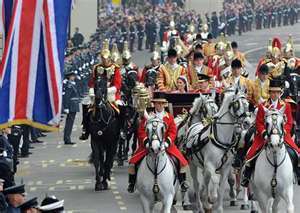
You can donate by sending a donation to Windsor Greys Jubilee Appeal, 35 Queen's Road, Windsor, Berkshire SL4 3BQ or by clicking here.[image error]
Published on June 09, 2012 23:33
June 8, 2012
WisRWA: Romancing the North Woods

The Wisconsin Romance Writers -- WisRWA -- sponsored Romancing the Northwoods in Wausau, WI on June 1-3, 2012. As usual, a great time was had by all.

Logo for the conference.
In addition to editors, agents, and writers of all shades from pre-published to multi-published, we had three outstanding speakers, all authors in the latter category: Elizabeth Hoyt, Jade Lee, and Lyn Cote.
 Elizabeth HoytElizabeth has written many romances, mostly set in the Georgian era, for Grand Central. Her website is here. She is currently a Rita finalist for her novel Scandalous Desires.
Elizabeth HoytElizabeth has written many romances, mostly set in the Georgian era, for Grand Central. Her website is here. She is currently a Rita finalist for her novel Scandalous Desires.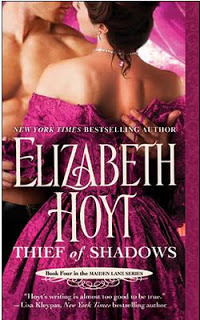
Elizabeth Hoyt gave several workshops: Stalking the Wild Agent, Dialogue: Writing Between the Lines, and We Don't Need No Stinkin' Muse. All were packed with info and lots of laughs as well.
 Jade Lee
Jade LeeJade Lee, aka Kathy Lyons, presented two workshops: The Core of Romance and The Business Side from Pre-Published to the NY Times List. Jade shared many of her experiences on this journey and had us all in stitches as well. Here website is here.
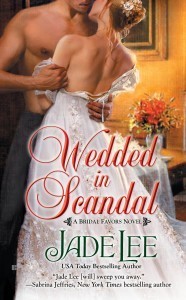
Jade writes historical romances set in Regency and Georgian England and for Harlequin's Blaze line as Kathy Lyons.
 Lyn Cote
Lyn CoteLyn Cote has found her niche in historical romance for inspirational publishers: Tyndale and Harlequion's Love Inspired lines in several genres. She is also getting into self-publishing.
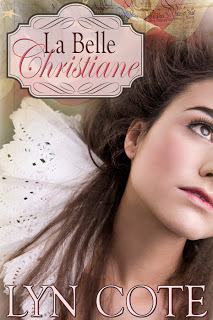
Lyn admitted to a special place in her heart for Christiane's story, which is available from most e-book sites including Kindle and Nook. Her website is here.
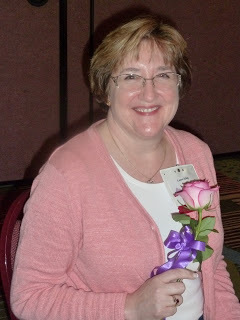 Among the multiple winners of The Write Touch Reader's Award was Laura Iding aka Laura Scott.
Among the multiple winners of The Write Touch Reader's Award was Laura Iding aka Laura Scott. Milwaukee area co-contact Barbara M. Britton was a Fab Five winner in the YA category.
Milwaukee area co-contact Barbara M. Britton was a Fab Five winner in the YA category.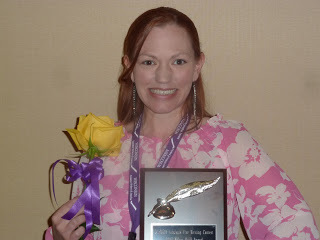 Winner of the Silver Quill Award in Fab Five Romantic Suspense was Liz Lincoln Steiner.
Winner of the Silver Quill Award in Fab Five Romantic Suspense was Liz Lincoln Steiner. Eileen Palma, Fab Five finalist in Single Title category
Eileen Palma, Fab Five finalist in Single Title category Anne Kenny was honored for finaling in RWA's Golden Heart Contest in the Regency Historical category. Good luck in Anaheim!
Anne Kenny was honored for finaling in RWA's Golden Heart Contest in the Regency Historical category. Good luck in Anaheim! Victoria's critique partners won raffle prizes: Denise Cychosz, Lauda Iding and Mary Brady.
Victoria's critique partners won raffle prizes: Denise Cychosz, Lauda Iding and Mary Brady. Cheryl Yeko sported that splendid first sale Pink Ribbon.
Cheryl Yeko sported that splendid first sale Pink Ribbon. And just to prove we really were in north central Wisconsin, I include the trees...it was a beautiful drive in lovely sunshine through lush green fields and forests from Milwaukee to Wausau and back.Thanks to all the organizers: Amy Bird, Eve James, Helen Johannes, Kristin Bayer, and many others.[image error]
And just to prove we really were in north central Wisconsin, I include the trees...it was a beautiful drive in lovely sunshine through lush green fields and forests from Milwaukee to Wausau and back.Thanks to all the organizers: Amy Bird, Eve James, Helen Johannes, Kristin Bayer, and many others.[image error]
Published on June 08, 2012 01:00
Kristine Hughes's Blog
- Kristine Hughes's profile
- 6 followers
Kristine Hughes isn't a Goodreads Author
(yet),
but they
do have a blog,
so here are some recent posts imported from
their feed.



